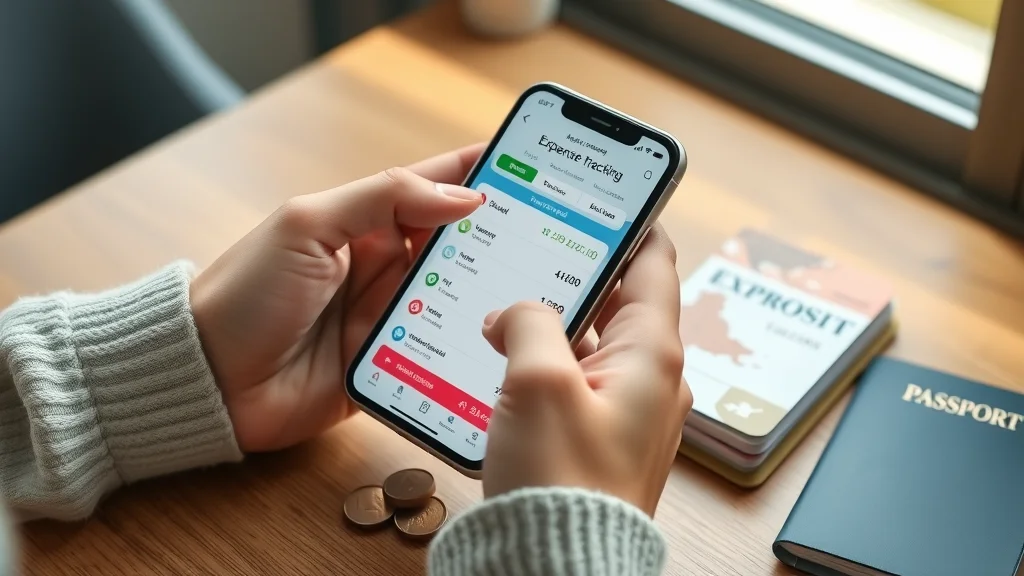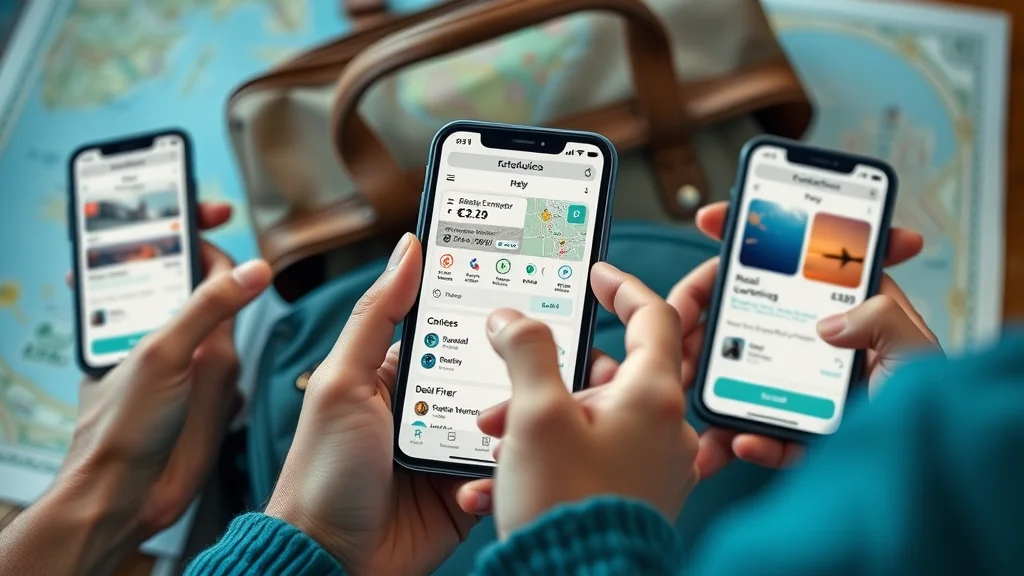
Ever dreamed of sipping coffee in Paris, backpacking through Southeast Asia, or taking an epic US road trip—only to give up, worried about overspending? Budget travel apps are changing the game, transforming the way smart travelers approach their next adventure. These digital companions don’t just help you save money—they put financial control right at your fingertips, giving you freedom to explore more, worry less, and make every journey feel extraordinary. If you want to stretch every dollar and create priceless travel memories, this guide is custom-made for you.
Unlocking Your Adventure: How Budget Travel Apps Revolutionize Travel Budgeting
The days of manually tracking receipts, juggling currencies, or splitting bills on the back of a napkin are over. Budget travel apps simplify every aspect of travel budgeting—from daily expense tracking to finding the best deals, logging group travel expenses, or managing your travel spend across continents. Whether it's planning routes, categorizing expenses, or getting real-time exchange rates, these apps ensure that every cent counts. With the right budgeting tool by your side, you can focus on what matters most: the experience of exploring the world.
For solo travel, these apps bring peace of mind and clarity, while for group travel, they eliminate the stress of shared costs and group expense debacles. Features like offline access are especially invaluable when you’re off the grid or navigating foreign locations without WiFi. As travel apps evolve, their budgeting tools pack in powerful travel planning features, seamless integrations, and intuitive interfaces. Choosing the right travel budget app maximizes your adventure, regardless of your destination or style.
Why Smart Travelers Choose Budget Travel Apps for Every Journey
"Budget travel apps don't just save you money—they empower you to travel further, smarter, and more confidently." – Leading Travel App Expert

What You’ll Learn in This Guide to Budget Travel Apps
- How to select the top travel budget app for your next trip
- Budgeting tools and features for smarter travel planning
- Criteria for evaluating the best travel apps
- Answers to popular travel budgeting questions
Top 15 Budget Travel Apps: Making Every Penny Count
1. Trail Wallet – The Favorite Travel Budget App for Expense Tracking
- Best for easy travel expense categorization
- Intuitive budgeting tool and tracking interface
- Offline access for seamless use abroad
Trail Wallet stands out as one of the most user-friendly budget travel apps for solo travelers and adventurers. Designed specifically for travel, it lets you track expenses by category, payment method, or trip—helping you stay on top of your daily budget no matter where you are. The app provides an intuitive interface with easy access to your expense log, making it a great tool for both rookie backpackers and seasoned globe-trotters. Its renowned offline access feature means you can log every coffee, museum entry, or taxi ride—even without internet connectivity.
With Trail Wallet, you can quickly add expenses, set daily and trip-wide spending limits, and see a breakdown of where your money goes. The budgeting tool helps you pinpoint problem areas in your travel spending, offers smart insights, and keeps your travel budget within reach. If you’re planning an extended international trip, Trail Wallet’s multi-currency support and user-friendly data export options provide flexibility for every scenario.

2. Trabee Pocket – Intuitive Budgeting Tool for Global Travelers
- Currency conversion capabilities
- Advanced travel expense report generation
For globetrotters who want more analytical power, Trabee Pocket offers deep budgeting tools wrapped in a stylish, customizable interface. It handles multiple currencies with real-time currency conversion so you always know precisely how much you’re spending in your home currency. Whether you’re adding expenses in Japanese yen or Brazilian reais, everything is processed smoothly for accurate travel budgeting.
Travelers appreciate Trabee Pocket’s robust expense tracking and visual report generation. You can tag and categorize each cost, analyze spending patterns, and download detailed summaries to share with companions or keep for your records. The ability to track expenses offline and export reports makes Trabee Pocket not just a great option for solo travel, but equally practical for business trips, group adventures, or even as a budgeting tool for multi-country journeys.
3. Splitwise – Group Travel Budget App for Shared Expenses
- Expense tracking and syncing for group travel
- Automated payment reminders
Group travel is fun but often comes with its own financial headaches—who paid for dinner, who owes who, and how to keep it all organized. Splitwise is the gold standard among budget travel apps designed for group travel expenses. Its seamless expense tracking and synchronization features ensure that everyone stays in the loop. You can easily add expenses for any member, from split accommodation to taxi rides, meals, and more.
Splitwise’s standout features include real-time tracking and automated reminders, so you never miss a payback or argue over lost receipts. With integrations that handle multiple currencies, offline access, and user-friendly reconciliation for group balances, Splitwise takes the awkwardness out of travel spending. This travel budget app is ideal for friends, families, and even business groups traveling together.

4. Mint – All-in-One Budget App with Travel Budgeting Features
- Track travel expenses alongside regular spending
- Budget alerts and savings recommendations
Mint is often hailed as the #1 budgeting app—and for good reason. It offers an all-in-one platform to sync your accounts, monitor travel expenses alongside daily costs, and receive smart alerts to prevent overspending. Mint’s travel-specific features make it an excellent budgeting tool for both quick getaways and longer vacations.
With Mint, you can create custom categories for any travel budget, set specific goals for hotels, car rental, or flights, and analyze spending in real-time. The app’s ability to integrate with your credit card and bank accounts means no expense gets missed. Helpful push notifications and tailored savings recommendations empower you to plan—and adapt—your travel budget confidently.
5. XE Currency – Currency Conversion for Savvy Travelers
- Realtime conversion for international budgeting
- Offline access to previous rates
Managing multiple currencies on the road can be tricky. XE Currency simplifies your life by providing up-to-date exchange rates and easy currency conversion—making it indispensable for travelers crossing borders or dealing with foreign markets. You can quickly convert your planned purchase into your home currency right from your phone, ensuring accurate travel budgeting and avoiding surprises.
XE Currency shines with its offline access, storing the latest rates locally so you’re never left guessing—even without internet. While not a full expense tracker, it pairs perfectly with other budget travel apps for a total travel planning solution. For anyone needing a quick conversion on transport, food, or shopping during an international trip, this app is a must-have.
6. Roadtrippers – Travel Planning App for Budget-Focused Road Trips
- Plan routes with optimized travel budgeting
- Access car rental and accommodation deals
Dreaming of hitting the open road? Roadtrippers is the quintessential travel app for mapping out cost-effective journeys. The app helps you plan scenic, expense-efficient routes by suggesting attractions, gas stations, and affordable eateries along your path. For meticulous travel budgeting, Roadtrippers allows you to estimate driving costs, link deals on car rental, and find wallet-friendly accommodations all in one place.
Roadtrippers isn’t just about navigation. Its built-in budgeting tools offer a bird’s-eye view of estimated travel spend. Families, friends, and solo travelers alike love its ability to integrate routes, points of interest, and budgeting for an efficient (and more fun) road trip. Whether it’s a cross-country adventure or a quick getaway, this tool keeps your travel expenses predictable and manageable.

7. Expensify – Advanced Expense Tracking for Business and Leisure Travel
- Receipt scanning and automated travel expense reports
- Multi-currency support
For meticulous travelers or business nomads, Expensify delivers robust expense tracking and reporting. Its receipt scanning makes travel expense logging instant and painless—just snap and upload! Expensify’s automation features generate detailed reports that you can categorize by project, date, or destination, ideal for both business trips and epic vacations.
Multi-currency handling and streamlined approval workflows make Expensify suitable for every international trip. Integration with corporate cards, customizable rules, and the ability to audit group travel spending means this budgeting tool is just as valuable for solo travelers as for company teams or family groups.
8. Wise – Budget App for Secure, Low-Cost International Transfers
- Streamlined money management across currencies
- Easy integration with other travel apps
When travel takes you across borders, Wise (formerly TransferWise) stands out for secure, low-cost transfers and real-time currency conversion. It’s a powerful budget app for managing your multi-currency balances, paying international bills, and making global purchases with ease. Wise’s straightforward design makes it easy to integrate with other travel budget apps and wallets.
Beyond simple transfers, Wise helps you avoid hidden fees, ensuring every transaction is transparent and tracked in your travel budget. Its automated processes and security features make it a trusted choice for solo travelers, digital nomads, and group travel organizers alike—anyone who wants to keep money matters simple while exploring the world.
9. Kayak – All-Purpose Travel App with Built-In Budget Tools
- Compares deals on flights, hotels, car rental for budget travel
- Travel planning tools with expense tracking
Kayak consolidates every phase of travel planning with its one-stop interface, bringing together the best deals on flights, hotels, and car rentals. Its in-app budgeting tools help you compare prices, save favorite options, and set price alerts for upcoming trips. Kayak’s tools for trip organization and expense tracking help you keep every detail under control.
Ideal for travelers who love to search and save, Kayak is popular for its simple UI and thorough market coverage, letting you get the most for your travel spending. It’s a great option for those looking to form a travel budget from the ground up, with the power to forecast costs and optimize every leg of your trip.
10. Hopper – Smart Budgeting for Flight and Hotel Bookings
- Predicts price drops for travel deals
- Notifies users when to book for best rates
Flight and hotel deals don’t have to be a guessing game. Hopper uses smart algorithms to predict the best times to book, ensuring you snag the lowest prices. Its real-time tracking and notification features mean you’ll always be in the know, maximizing your budget travel potential.
Hopper’s color-coded calendar and predictive analytics aren’t just for bargain hunters—they add precision to any travel planning session. Beyond flights, Hopper also covers hotels and even car rentals, rounding out its offering as a well-rounded budget app for cost-conscious adventurers. Set your travel dates, input preferences, and let Hopper do the heavy lifting for maximizing your travel spend.
11. Google Travel – Free Travel Planning and Budgeting Tools
- Consolidates travel plans, tracks reservations, and estimates travel expenses
Google Travel is an integrated platform offering a seamless travel planning experience. It gathers all your reservations—flights, hotels, activities, and car rentals—into a single itinerary, making it easy to manage your travel budget and stay organized on the go.
One of the most compelling features is Google Travel’s free cost estimates and integrated map view, aiding at every step from booking to budgeting. It’s ideal for travelers who don’t want to pay for a separate budget app or who appreciate the convenience of syncing their plans across devices. Detailed spending reports and real-time alerts round out its robust set of travel budgeting features.
12. Trail Wallet vs. Trabee Pocket – Comparing Two Top Travel Budget Apps
| Feature | Trail Wallet | Trabee Pocket |
|---|---|---|
| Expense Tracking | Yes | Yes |
| Currency Conversion | Yes | Yes |
| Offline Access | Yes | Yes |
| Platform | iOS | iOS/Android |
| Unique Feature | Simple UX | Advanced Reports |
Both Trail Wallet and Trabee Pocket are leading travel budget apps known for their detailed expense tracking and reliable offline functionality. Trail Wallet attracts users with its straightforward interface and seamless iOS performance, while Trabee Pocket’s advanced reporting and Android compatibility give it a broader audience. Both deliver top-tier travel budgeting solutions, but your best fit depends on platform preference and desired analytics.
13. Plum – Automated Budget App with Group Travel Features
- Savings automation and travel budget suggestions
- Ideal for solo travel and couples
Plum leverages the power of automation to help you save painlessly for your next big trip. Its intelligent algorithms analyze your spending, move small amounts into savings, and provide smart travel budget suggestions. The app’s group features enable easy management of shared expenses—whether traveling as a couple or with friends—which is a rare find among budgeting tools.
Plum’s standout feature is its automatic saving model—perfect for those who struggle to set aside travel funds manually. Whether you’re preparing for solo travel or organizing a group getaway, Plum pairs proactive budgeting with effortless execution, easing your path toward more frequent and fulfilling adventures.

14. Emma – Comprehensive Budgeting Tool with Travel Categories
- Syncs multiple accounts and tags travel expenses
- Smart budgeting tools for detailed analysis
For hands-on travelers who want a macro view of their finances, Emma brings clarity and control. This budget app syncs all your accounts, tags travel expenses, and helps you analyze travel spend in real time. Emma’s budgeting tools make it easy to assess how trips impact your overall financial picture, from flights to daily lattes and even credit card charges.
Emma is excellent for frequent fliers or anyone balancing multiple payment methods and currencies. With custom budgeting categories and expanded analytics, you get actionable insights and recommendations for smarter travel budgeting and planning. It’s especially helpful for those looking to grow from basic expense tracking to a more holistic, forward-thinking approach.
15. Dave Ramsey’s EveryDollar – Zero-Based Budgeting for Travelers
- Structured budgeting for each travel category
- Incorporates Dave Ramsey’s financial principles
Fans of Dave Ramsey’s financial philosophy unite: EveryDollar is a budget app rooted in proven zero-based budgeting. Travelers can allocate every dollar before their trip even begins, adjusting line items for accommodation, meals, entertainment, and shopping along the way. The app encourages ongoing check-ins so no travel expense goes overlooked.
EveryDollar brings structure to your travel budget without sacrificing flexibility. By assigning a purpose for each dollar, it removes surprises and offers peace of mind—a great choice for those who want financial discipline while enjoying everything a destination offers. For budget-focused families, solo wanderers, and group travel planners, EveryDollar helps make every cent count.
Criteria for Choosing the Best Budget Travel Apps
- Travel budgeting and expense tracking capabilities
- Currency conversion and offline access
- Group vs. solo travel compatibility
- Integration with other travel apps
- User reviews and travel planning features

The best budget travel apps aren’t just about tracking pennies—they’re about powerful travel planning, seamless group management, flexible offline access, and robust expense tracking. Look for platforms that offer real-time currency conversion, adapt to both group travel and solo travel, and provide user-friendly integration with your favorite travel planning features. Always check user reviews for feedback on reliability, updates, and customer support.
Ultimately, your ideal app should streamline your travel experience while empowering you to make smarter financial decisions. Whether you want detailed reports, instant notifications, or simple automation, matching the right tool to your travel style saves time, money, and stress.
Benefits of Using Budget Travel Apps for Travel Budget & Expense Tracking
- Improve travel expense management
- Find better travel deals
- Access real-time insights for smarter travel budgeting
- Seamless travel planning

Digital budgeting tools put actionable insights and travel spending power in your hands. With automated tracking, access to deals, and the ability to monitor expenses in real-time, you can allocate resources smartly and maximize every experience. Many travel budget apps also help you analyze past trip data to improve future itineraries, unlocking even more savings over time.
The convenience of having a portable finance advisor means fewer surprises, better deals, and easier travel planning. From comparing nightly rates on accommodations to managing shared costs for group travel, budget travel apps make even complex trips manageable and more affordable.
The Power of Budgeting Tools for Smarter Travel Planning
- Create and manage your overall travel budget
- Monitor travel expenses in real-time
- Apply budgeting tools to group or solo travel
Today’s budgeting tools offer more than expense tracking—they provide streamlined management for every part of your trip. You can set up a daily budget, monitor costs by category, and decide whether each purchase fits your goals. With advanced group features, splitting bills and tracking who paid becomes effortless, reducing friction on group travel. These tools encourage mindful spending and allow you to adapt on the fly, making your adventures not just more affordable, but also less stressful and more enjoyable.
By applying smart travel budgeting, travelers can map out future trips with confidence, knowing that every lesson learned translates to greater savings and better planning. The power lies in having accurate, up-to-date information right where you need it.
Lists: Hidden Features You Shouldn’t Miss in Your Travel Budget App
- Expense tracking automation
- Offline access
- Custom currency conversion
- Multi-platform syncing
- In-app travel deals

Many budget travel apps are packed with features that go beyond the basics. Automation means new expenses are categorized and tracked the moment they’re logged, while offline access ensures you stay on budget even in remote areas. Look for apps offering custom currency conversion, allowing you to lock in rates and compare costs with ease. The most convenient platforms offer seamless multi-device syncing and in-app travel deals that help you save right when you book.
By tapping into these hidden features, you unlock even more ways to optimize your travel budget and streamline your journey from planning to landing. Whether it’s finding a last-minute discount or keeping your spending log up-to-date, these tools make every dollar go further.
Expert Quotes: Why Budget Travel Apps Are Indispensable
"With real-time expense tracking and currency conversion, today’s budget travel apps make travel budgeting effortless." – Financial Technology Analyst
People Also Ask: What is the best app for travel deals?
Answer: Explore Hopper, Kayak, and Google Travel for the best travel deals tailored to your needs.
People Also Ask: What is the #1 budgeting app?
Answer: Mint consistently ranks as the #1 budgeting app due to its comprehensive features and easy travel expenses tracking.

People Also Ask: Is Plum or Emma better?
Answer: For travel budgeting, Plum is notable for automation, while Emma offers detailed travel expense insights — choose based on your preference.
People Also Ask: What is Dave Ramsey's favorite budget app?
Answer: Dave Ramsey’s favorite budget app is EveryDollar, following his proven zero-based budgeting approach for travel budgeting and more.
FAQs: Budget Travel Apps
-
How secure are budget travel apps?
Most reputable budget travel apps use bank-level encryption and privacy safeguards to protect your data. Check app privacy policies and reviews before syncing accounts. -
Do budget travel apps work offline?
Many top travel budget apps like Trail Wallet and Trabee Pocket offer offline access, allowing you to log travel expenses and check your daily budget without WiFi or data connections. -
Can I use a travel budget app for group travel?
Yes! Apps like Splitwise and Plum are specifically designed to manage group travel expenses, streamline payments, and ensure fair cost sharing. -
What is the difference between a budget app and a travel budgeting tool?
A budget app manages overall finances, while a travel budgeting tool focuses on tracking and planning travel expenses—but many apps now combine both for flexibility. -
Which budget travel apps are best for solo travel?
For solo travelers, Trail Wallet, Trabee Pocket, and Wise offer simple interfaces, robust offline access, and easy travel expense tracking.

Key Takeaways from the Best Budget Travel Apps Guide
- Budget travel apps simplify tracking, planning, and saving
- Best apps combine travel planning, expense tracking, and currency conversion
- Choosing the right travel budgeting tool can save you considerable money and stress
Stretch Farther: Make Every Adventure Affordable with Budget Travel Apps
- Experiment with different travel apps for optimal savings
- Share your experiences with budget travel apps to help fellow travelers

 Add Row
Add Row  Add
Add 


Write A Comment